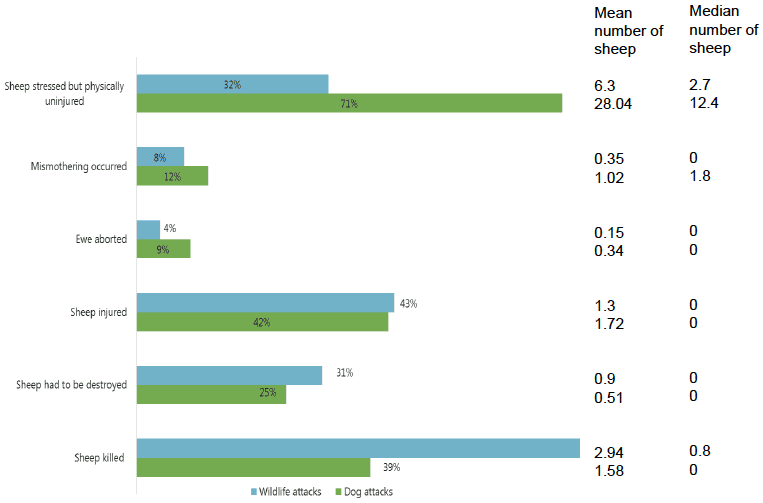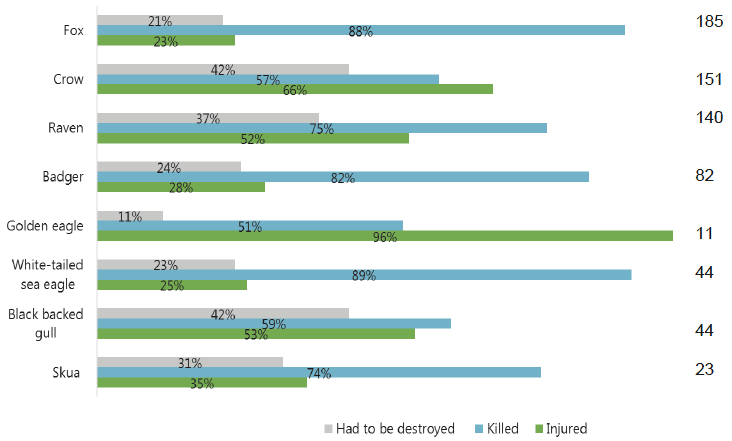Sheep attacks and harassment: research
Findings from survey research on sheep worrying and wildlife attacks on sheep.
6. Impact on sheep of attacks
This chapter outlines the ways in which sheep have been affected by attacks.
Survey respondents who reported at least one attack on their sheep within the last twelve months were asked to describe the most recent attack. Questions explored the numbers of sheep affected in the most recent attack; the nature of the impacts on their sheep; and what type(s) of sheep were affected.
Impact of dog attacks compared with wildlife attacks
The figure below shows the proportion of wildlife and dog attacks that have affected at least one sheep in each of the ways listed, and the columns beside indicate the mean and median number of sheep affected in each way per attack. For example, in 71% of the most recent dog attacks reported, at least one sheep was stressed but physically uninjured, the mean number was 28.04 and the median number was 12.4. By comparison, in 32% of the most recent wildlife attacks at least one sheep was stressed but physically uninjured, the mean number affected in this way was 6.3 and the median was 2.7. As is evident, a relatively high proportion of attacks resulted in sheep being injured, destroyed or killed.
Figure 6.1 Proportions of wildlife and dog attacks which have affected at least one sheep in the ways outlined (% farmers reporting each in relation to the most recent attack)

Base: All those who had experienced a wildlife attack (840) or a dog attack (293) in the last year
Farmers were more likely to report that pregnant or lactating ewes were affected by dog attacks than other types of sheep. Of the farmers reporting that their sheep had been killed in the most recent incident, forty-four per cent reported that at least one pregnant or lactating ewe had been killed. By comparison, 20% reported that at least one lamb had been killed, 18% that a dry ewe or gimmer had been killed, 23% that a hogget had been killed and 6% that a ram/tup had been killed.[48]
Pregnant or lactating ewes were also the most likely to have had to be destroyed as a result of a dog attack with 44% of farmers who had had to destroy at least one sheep reporting that at least one pregnant or lactating ewe had had to be destroyed (compared to 11% reporting a lamb having to be destroyed, 20% reporting a dry ewe or gimmer, 19% reporting a hogget and 8% reporting a ram/tup).
Impact of wildlife attacks
The figure below shows the percentage of attacks attributed to each species that resulted in at least one sheep being injured, killed or having to be destroyed. Attacks by white-tailed sea eagles and foxes were most likely to be thought responsible for killing at least one sheep (in 89% and 88% of attacks attributed to these species respectively).
Figure 6.2 % of attacks attributed to each species in which at least one sheep was injured, killed or had to be destroyed

Injury was the second most frequently reported impact on sheep from wildlife attacks, with 43% of farmers reporting that at least one sheep had been injured in an attack. The mean number of sheep injured in a single wildlife attack was lower than in a single dog attack (mean of 1.3 in wildlife attacks, compared to a mean of 1.78 in dog attacks). Attacks by golden eagles were most likely of all wildlife attacks to result in injury with 96% of incidents with this species resulting in at least one sheep being injured.
With regard to the types of sheep affected, in contrast to dog attacks where pregnant or lactating ewes tended to be more affected than other types of sheep, more lambs, defined as under 1 year old, were reported to have been killed, destroyed or injured by wildlife than any other types of sheep.
Eighty-one per cent of farmers reporting that at least one sheep had been killed in their most recent wildlife attack reported that at least one lamb had been killed (compared to 18% reporting that at least one pregnant or lactating ewe had been killed, 4% reporting that a dry ewe or gimmer had been killed, 4% reporting a hogget and <1% reporting a ram/tup). Similarly, 61% of farmers whose sheep had had to be destroyed reported that this included at least one lamb (compared to 36% who stated that it included at least one pregnant or lactating ewe, 4% at least one dry ewe or gimmer, 4% at least one hogget, and <1% a ram/tup). The rate of injuries (as opposed to deaths) from wildlife attacks were broadly similar among lambs and pregnant or lactating ewes however; while around half (54%) of farmers whose sheep had been injured by a wildlife attack reported at least one injured lamb, almost as many (41%) reported at least one injured ewe.
Respondents were asked not to include the scavenging of dead sheep when reporting the numbers affected. However, it is not always easy to tell whether a sheep was already dead/dying so it may be that some of those reported as having been killed had already died from some other cause. Similarly, some of the sheep preyed on (particularly young lambs) may have been relatively weak and may not have survived anyway. Though, on this last point, sheep farmers in the qualitative research were keen to dispel the notion only the weakest lambs were preyed on and cited examples where they had witnessed sea eagles (for example) taking strong, healthy lambs and, in one instance, a large hogget.
Contact
Email: socialresearch@gov.scot
There is a problem
Thanks for your feedback